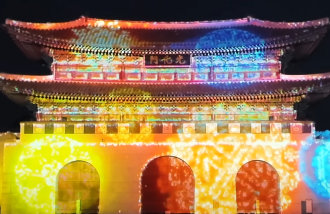Gaya Tumuli highly likely to be added in UNESCO World Heritage List
Gaya Tumuli highly likely to be added in UNESCO World Heritage List
Posted May. 12, 2023 07:51,
Updated May. 12, 2023 07:51
A group of burial mounds built by the ancient federation known as Gaya, which thrived in the southern part of the Korean peninsula from the first to sixth centuries AD, is highly expected to become a UNESCO World Heritage this September.
On Thursday, the Cultural Heritage Administration (CHA) announced that the International Council on Monuments and Sites (ICOMOS), an advisory body in charge of evaluating candidates for UNESCO World Heritage, recommended registering the Gaya tumuli on the list. Although the final decision is to be made by the World Heritage Committee this September, the candidate will likely make it to the list.
The Gaya tumuli, the candidate in question, consists of seven mounds: the Gimhae Daeseong-dong Tumuli, Haman Marisan Tumuli, Hapcheon Okjeon Tumuli, Goryeong Jisan-dong Tumuli, Goseong Songhak-dong Tumuli, Changnyeong Gyo-dong, and Songhyeon-dong Tumuli and Namwon Yugok-ri and Durak-ri Tumuli.
The ancient Korean federation of Gaya refers to six polities, including Geumgwan Gaya that thrived from the first century AD to 562 around the Nakdong River. Although Gaya’s relatively lacking literature records compared to Baekje, Silla, and Goguryeo, its tumuli and relics excavated across the territory provide a window into the historical and cultural aspects of the federation. Given prestige goods discovered in the Gaya tumuli, a representation of the social class of the buried, imply social egalitarianism during the era, it is assumed that Gaya ran a horizontally equalized federal system.
The ICOMOS saw value in the Gaya tumuli as a potential member of the UNESCO World Heritage, assessing that it holds historically unparalleled significance as evidence of the extinct cultural traditions and civilizations. It evaluated that the Gaya tumuli not only show the federation’s endeavors to maintain coexistent, autonomous and cooperative relationships with its neighbors but also serve as clear evidence of the diversity of the ancient East Asian civilizations, making it a potentially qualified World Heritage, said the CHA.
Whether the Gaya tumuli will be part of the World Heritage list is finally determined by the 45th World Heritage Committee scheduled from Sept. 10 to 25 in Riyadh, Saudi Arabia. If it makes it to the list, South Korea will have a total of 16 World Heritages.
always99@donga.com



![[이철희 칼럼]강대국 결탁의 시대가 온다](https://dimg.donga.com/c/138/175/90/1/wps/NEWS/IMAGE/2025/12/29/133059163.1.png)



